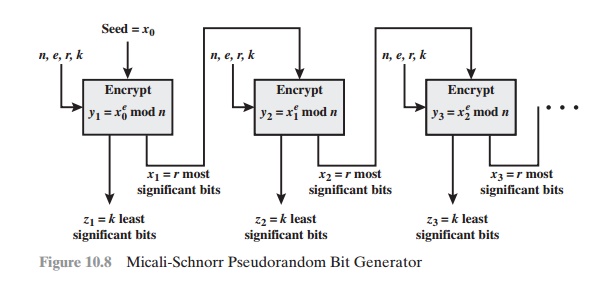Chapter: Cryptography and Network Security Principles and Practice : Asymmetric Ciphers : Other Public-Key Cryptosystems
Pseudorandom Number Generation Based on an Asymmetric Cipher
PSEUDORANDOM NUMBER
GENERATION BASED ON AN ASYMMETRIC CIPHER
We noted in Chapter 7 that because a symmetric block cipher
produces an apparently random output,
it can serve as the basis of a pseudorandom number generator (PRNG). Similarly, an asymmetric encryption algorithm produces apparently random output and can be used to
build a PRNG. Because asymmetric
algorithms are typically much slower than symmetric algorithms, asymmetric
algorithms are not used to generate
open-ended PRNG bit streams. Rather,
the asymmetric approach is
useful for creating a pseudorandom function (PRF) for generating a short
pseudorandom bit sequence.
In this section, we examine two PRNG designs
based on pseudorandom functions.
PRNG Based on RSA
For a sufficient key length, the RSA
algorithm is considered secure and is a good candidate to form the basis of a
PRNG. Such a PRNG, known as the Micali-Schnorr PRNG [MICA91], is recommended in
the ANSI standard X9.82 (Random Number
Generation) and in the ISO standard 18031 (Random Bit Generation).
The PRNG is illustrated in Figure
10.8. As can be seen,
this PRNG has much the same structure as the output
feedback (OFB) mode used as a PRNG (see Figure 7.3b and
the portion of Figure 6.6a enclosed with a dashed
box). In this case, the encryption algorithm is RSA rather than a symmetric block cipher. Also, a portion of
the output is fed back to the next iteration of the encryption algorithm and the remain-
der of the output is used as pseudorandom bits. The motivation for this separation of the output into two distinct
parts is so that the pseudorandom bits from one stage do not provide input to the next stage.
This separation should contribute to forward unpredictability.

We can define the PRNG as follows.

The variable strength in
requirement 4 is defined in NIST SP 800-90 as follows:
A number associated with the amount of work (that is, the number of operations) required to break a cryptographic algorithm or system; a security strength
is speci- fied in bits
and is a specific value from the set (112, 128, 192, 256) for this Recommendation. The amount of work needed is 2strength.
There is clearly
a tradeoff between r and k. Because RSA is computation- ally intensive compared to a block cipher,
we would like to generate
as many pseudorandom bits per iteration as
possible and therefore
would like a large value of k. However, for cryptographic strength, we would like r to be as large as possible.
For
example, if e = 3 and N = 1024 , then we have the inequality 3r 7 1024,
yielding a minimum required size for r of 683 bits. For r set to that size, k =
341 bits are generated for each exponentiation (each RSA encryption). In this
case, each exponentiation requires only one modular squaring of a 683-bit
number and one modular multiplication. That is, we need only calculate 1xi
* 1xi mod n22mod n .
PRNG Based on Elliptic Curve Cryptography
In this subsection, we briefly summarize a technique developed by the U.S. National Security Agency (NSA) known as
dual elliptic curve PRNG (DEC PRNG). This technique is recommended in NIST SP
800-90, the ANSI standard X9.82, and the ISO standard 18031. There has been some controversy regarding
both the security and efficiency of this algorithm compared to other
alternatives (e.g., see [SCHO06], [BROW07]).
[SCHO06] summarizes the algorithm as
follows: Let P and Q be two known points on a given elliptic curve. The seed of
the DEC PRNG is a random integer s0 Î {0, 1, ...... , #E(GF(p)) - 1}, where # E(GF(p)) denotes the
number of points on the curve.
Let x denote a function
that gives the x-coordinate of a point of the curve. Let
lsbi1s2 denote the i least significant bits of
an integer s. The DEC PRNG trans- forms the seed into the pseudorandom sequence of length 240k, k > 0, as follows.

Given the security
concerns expressed for this PRNG, the only motivation for its use would be that it is used in a system that already
implements ECC but does not implement any other symmetric, asymmetric, or hash
cryptographic algorithm that could
be used to build a PRNG.
Related Topics